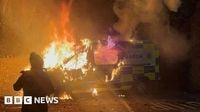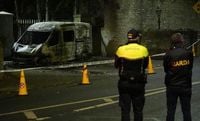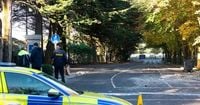Violence erupted on the outskirts of Dublin this week as protests outside the Citywest Hotel, an accommodation center for asylum seekers in Saggart, spiraled into two nights of chaos, leaving the Irish capital grappling with the fallout. The unrest was triggered by reports of the alleged sexual assault of a 10-year-old girl near the hotel on Monday morning, October 20, 2025. According to BBC News and Time, a 26-year-old male suspect was swiftly arrested and appeared in court the following day, charged in connection with the incident.
What started as a demonstration in response to the alleged crime quickly escalated. By Tuesday evening, October 21, hundreds—eventually swelling to around 1,000—had gathered outside the Citywest Hotel. The crowd, initially a mix of peaceful protesters and others, soon turned violent. As The Irish Times and Time reported, Gardaí (Irish police) faced a barrage of bricks, fireworks, glass bottles, and even wooden planks. A Gardaí van was set ablaze, and a police helicopter circling overhead was targeted with a laser.
Chief Superintendent Michael McNulty described the ordeal his officers faced: “This was not a peaceful protest. The violence exhibited was thuggery and an attempt to intimidate and injure.” He detailed how some individuals attempted to breach police cordons by charging with horse-drawn sulkies, while others armed themselves with garden forks and tools, even damaging local walls to create makeshift missiles.
To restore order, the Gardaí deployed an extensive array of resources—approximately 300 officers, including 125 in uniform and 150 from the Public Order Unit, supported by mounted and dog units, water cannon, and air support. According to The Irish Times, the situation was so volatile that police were forced to use pepper spray after attempts were made to break through the cordons. The Luas Red Line tram service was suspended between Belgard and Saggart, and the Saggart stop was vandalized during the unrest.
In the aftermath, six people were arrested. Five men—two in their 50s and three in their 40s—were charged with public order offenses and appeared before the Criminal Courts of Justice. A woman in her 50s, also detained, was released without charge pending a file for Ireland’s Director of Public Prosecutions. Another man in his 30s was arrested later for an alleged offense of violent disorder.
Acting Deputy Garda Commissioner Paul Cleary emphasized the calculated nature of the disorder, stating on RTÉ’s Morning Ireland that the violence had been orchestrated online: “We know that even though people may have been wearing hoods or masks, we still have the ability to identify them and bring them before the courts, and we will pursue that relentlessly.” Cleary noted the mix of participants: “The protest included a mix of some peaceful protesters, youths on horses and scramblers and violent thugs who were there purely to incite violence and promote fear.”
The Gardaí’s response was described as robust but measured. Commissioner Justin Kelly condemned the violence unequivocally: “An Garda Síochána facilitate peaceful protest on a daily basis. This was obviously not a peaceful protest. The actions this evening can only be described as thuggery. This was a mob intent on violence against Gardaí.” He praised the professionalism and courage of officers, saying, “Public order units, dog unit, mounted unit, air support and the water cannon were deployed along with front-line colleagues, which brought the situation to a conclusion. We will now begin the process of identifying those who committed crimes and we will bring those involved in this violence to justice.”
Irish Minister for Justice Jim O’Callaghan also weighed in, warning against the weaponization of crime to sow division. “Unfortunately, the weaponizing of a crime by people who wish to sow dissent in our society is not unexpected. The Gardaí are prepared for this, but attacking Gardaí and property is not an answer, and won’t help to make anyone feel safe,” he told reporters. O’Callaghan stressed that there was no ongoing threat to public safety and condemned the attacks on police and property as “unacceptable.” He added, “It is clear to me from talking to colleagues during the day and this evening that this violence does not reflect the people of Saggart. They are not the people participating in this criminality, but rather the people sitting at home in fear of it.”
Political leaders across the spectrum denounced the violence. Taoiseach (Prime Minister) Micheál Martin “strongly condemned” the disorder, praising the frontline Gardaí for their swift and courageous action. “There can be no justification for the vile abuse against them, or the attempted assaults and attacks on members of the force that will shock all right-thinking people,” Martin declared. He emphasized that An Garda Síochána has a proud tradition of protecting the Irish people and that such violence would not be tolerated.
Presidential candidates also addressed the nation’s shock. Heather Humphreys called the scenes “absolutely horrific” during a televised debate, stating, “There are men and women of An Garda Síochán being attacked and missiles are being thrown at them. This is wrong. This is not what we are as a country.” Humphreys, a former Minister of Justice, also highlighted the need to break down prejudices toward immigrants, noting their vital contribution to the Irish economy. Catherine Connolly, another presidential hopeful, described the riots as “very, very upsetting” and urged caution about deepening divisions within Irish communities.
As BBC News and The Irish Times both noted, the protest at Citywest was not an isolated incident. Ireland, like several other European countries, has seen tensions rise over immigration and asylum policies, with far-right and anti-immigration groups increasingly leveraging social media to organize demonstrations and spread inflammatory rhetoric. The Citywest riots were explicitly promoted online, and footage showed protesters waving Irish flags and chanting anti-immigration slogans.
These events echo similar unrest in Northern Ireland earlier in 2025, when protests in Ballymena followed the charging of two teenage boys of Romanian descent with attempted rape. Those demonstrations also escalated into violence targeting ethnic minority families and police officers, underscoring the volatile intersection of crime, migration, and social tensions.
In the wake of the Citywest Hotel riots, investigations are ongoing. A Senior Investigating Officer has been appointed, and two scenes remain preserved for forensic and technical examination. Authorities have pledged a relentless pursuit of those responsible, with operational activity and heightened security measures still in place around the hotel and the wider Saggart area.
While the dust begins to settle in Dublin, the events of this week have left an indelible mark on the city’s sense of security and community. Leaders from all corners of Irish society have called for calm, unity, and a reaffirmation of the country’s democratic values—insisting that, even in the face of tragedy and outrage, violence is never the answer.


